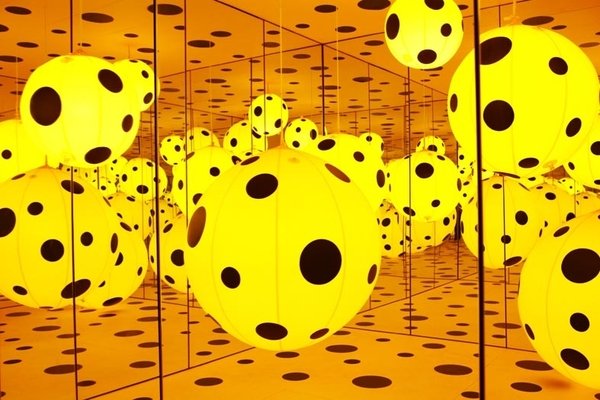Big in Japan
dal 18/6/2009 al 15/8/2009
Segnalato da
18/6/2009
Big in Japan
Contemporary Art Centre - CAC, Vilnius
Yayoi Kusama, Paramodel, Hiraki Sawa, Go Watanabe. The curators - Renata Dubinskaite and Kestutis Kuizinas - have imagined the exhibition as a set of four discrete solo-projects; affording the artists to produce large-scale installations that the audience can truly immerse themselves inside. Each exhibition space is made over as a distinctive artistic world or dream space and is reflective of the powerful visuality present in contemporary Japanese culture and art.

Curated by: Renata Dubinskaite and Kestutis Kuizinas
The Contemporary Art Centre is proud to launch the first major exhibition of
Japanese contemporary art presented in Lithuania. Big in Japan continues the CAC's
dynamic Vilnius culture capital year program – showcasing the latest developments in
contemporary art from around the world.
The curators of Big in Japan have imagined the exhibition as a set of four discrete
solo-projects; affording the artists to produce large-scale installations that the
audience can truly immerse themselves inside. Each exhibition space is made over as
a distinctive artistic world or dream space and is reflective of the powerful
visuality present in contemporary Japanese culture and art.
Yayoi Kusama has been producing all encompassing environments since the 1960s and at
the CAC presents an installation that couples one of her classic mirror chambers
with her recurring allover polka dot motif “Dots Obsession - Infinity Mirrored Room”
(2008). The dots that recur in her work are a visualisation of an illness that
Kusama (who is now in her eighties) has suffered from since childhood that occludes
her vision in a field of spots. While her work is emblematic of this sad affliction
her use of colour, and inflatable sculptures, that retain a naive and playful
quality, makes her work a joy to experience.
Paramodel, an artist duo from Osaka, has transformed the upstairs transition spaces
of the CAC into a 360 degree fantastical toy railroad – with plastic tracks, and
painted decorations, running up the walls and across the ceiling in what looks like
garden of tendrils. The work, titled “Paramodelic – Graffiti” (2009), takes its
allover and dispersed properties from graffiti's aesthetics. The organic sprouting
of the tracks makes the space into what seems to be an artificial hothouse
environment; or a wonderful toyshop from children's fiction. Of course, references
to artificial nature, mass transit, and trains, are also imbued with more critical
meanings that the audience can reflect upon.
London-based artist Hiraki Sawa, in his synched six-screen video installation “Hako”
(2007), slowly merges images of one of Japan’s nuclear power plants, a forest
preserved by Shinto monks, bizarrely churning sea, and multiple landscapes and
interiors. Each of these images balances on the blurry line between the natural and
artificial, and the real and surreal. Meanwhile, the exact local time is ticking
away on a dollhouse clock set against a white wallpaper background in still-frame,
which makes the scenes seem like interior visions, and dreamlike, rather than views
of the world.
Go Watanabe has created six new light box mounted android portraits (No. 26-31) from
his “Face ('Portrait')" (2005-2009) series especially for Big in Japan. Watanabe's
stunning alien faces appear to be staring directly at the viewer, although it is
clear that they are not sentient beings and do not possess the power of sight. The
beautiful albinos in the images might look identical at first glance, yet there are
subtle differences between them; each portrait is constructed from a different image
of a face and shares that referents skin, facial structure, and hair growth.
Paradoxically, the uniqueness of human skin becomes apparent when several portraits
appear in proximity and lends a lifelike appearance to these artificial images.
Big in Japan is accompanied by a catalogue, which features texts by the exhibition’s
curators and artists, and full colour photography of the artists' works.
The CAC Reading Room will provide visitors with an opportunity to explore new books
about Japanese culture, art, design and architecture, donated by the Embassy of
Japan in Lithuania on the occasion of this exhibition.
Image: Yayoi Kusama. Dots Obsession – Infinity Mirrored Room. 2008 (installation view)
Opening: Friday 19 June at 6 pm
Film screening: Saturday 20 June at 9 pm
Yoji Yamada’s feature “Kinema no tenchi” (“Final Take: The Golden Days of Movies”,
117 min., 1986, English subtitles) in the CAC Cinema Hall. The screening is
supported by the Embassy of Japan in Lithuania.
On Saturday 20 June, as part of the “Vilnius – European Capital of Culture 2009”
project “Let There Be Night!” the exhibition “Big in Japan” will be open until 10
pm. Free Admission
Press and promotions:
Renata Dubinskaite renata@cac.lt
Contemporary Art Centre - CAC
Vokieciu 2 - Vilnius
Opening hours
Tuesday - Sunday 12:00 - 19:30



